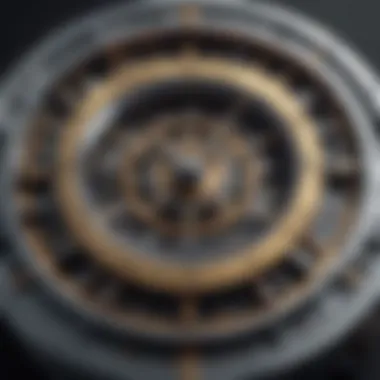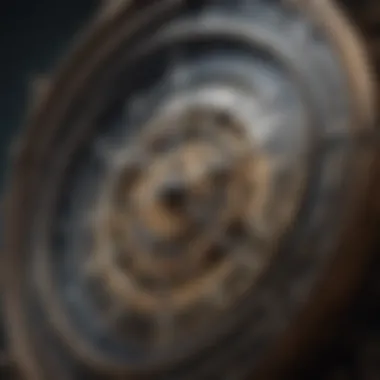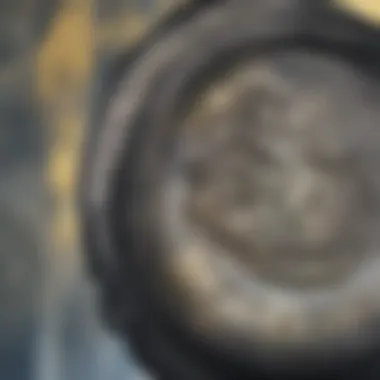Exploring the Long Clock: Timekeeping Beyond Limits


Intro
The concept of time has always fascinated humanity. While most traditional clocks measure time in hours, minutes, and seconds, the long clock pushes our comprehension to new lengths. This article explores the mechanisms, significance, and implications of long clocks, offering an in-depth narrative that spans historical context and future projections. Through this meticulous examination, we aim to highlight how these devices not only represent advancements in timekeeping but also symbolize deeper human pursuits in understanding the fabric of our existence.
Article Overview
Purpose of the Article
This piece aims to dissect the intricate workings of long clocks, their historical developments, and their potential impacts across various fields. Long clocks are not just technological marvels; they are philosophical and social symbols reflecting humanity’s quest to quantify and understand time. By engaging with the long clock, we aim to rejuvenate discussions about time and what it means in contemporary society.
Relevance to Multiple Disciplines
The exploration of long clocks intertwines various academic disciplines, including physics, history, and philosophy. In physics, the precision and mechanisms of long clocks can lead to advancements in our understanding of time itself. In history, they serve as artifacts that mark the evolution of timekeeping throughout different cultural periods. Philosophically, long clocks provoke questions about perception and the nature of time. This multifaceted relevance engages students, researchers, educators, and professionals alike, inviting them to ponder deeper implications of time in their respective fields.
Research Background
Historical Context
Long clocks have roots that extend back centuries, reflecting the intellectual and technological awakenings of the past. The desire for accurate time measurement emerged with the rise of navigation and the need for precise timekeeping to guide maritime exploration. Devices like the orrery and marine chronometer became pivotal during the Age of Enlightenment, when science and reason began to prevail over superstition.
Key Concepts and Definitions
To understand long clocks, it is crucial to define certain terms:
- Long Clock: A timekeeping device specifically designed to measure time over extended periods, often years or centuries.
- Chronometry: The science of measuring time accurately.
- Temporal Measurement: The practice of quantifying the passage of time.
By establishing a foundation on these key concepts, we clarify the sophisticated operations of long clocks and their broader implications on human cognition and societal frameworks.
"The measure of time forms a fundamental part of human experience, shaping cultures, religions, and philosophies across ages."
"The measure of time forms a fundamental part of human experience, shaping cultures, religions, and philosophies across ages."
Long clocks are at the intersection of technology and humanity's timeless quest for understanding the passage of time.
Prologue to Long Clocks
Long clocks are significant devices in the study of timekeeping, showcasing both the engineering prowess and the philosophical inquiries of humanity over centuries. These sophisticated mechanisms allow us to measure time with unprecedented accuracy, ideally stretching our understanding of temporal dynamics. In this article, we will explore various aspects of long clocks, from their intricate mechanisms to their far-reaching cultural implications. Understanding these devices is vital not only for historical context but also for appreciating their role in shaping modern interpretations of time.
Definition and Overview of Long Clocks
A long clock typically refers to timekeeping devices designed for precision and longevity, often with a focus on maintaining accurate time across extensive periods. Unlike everyday clocks which may serve utility purposes, long clocks represent a commitment to quality craftsmanship. They often incorporate elaborate gears and weights to regulate time, reflecting a blend of functionality and artistry. At their core, long clocks embody the complex relationship between human beings and the notion of time, allowing us to organize and understand our lives through careful measurement.
Although various designs exist, long clocks share common characteristics. They often feature pendulums or escapements, which filter energy to ensure steady operation. Many long clocks are beautifully decorated, serving as more than mere time-telling devices; they are also pieces of art, often passed down through generations. Despite modern advancements in timekeeping technologies, the allure of long clocks remains intact, representing a significant chapter in the narrative of horology.
Historical Significance of Timekeeping Devices
The evolution of timekeeping devices has been pivotal in shaping human civilization. Early civilizations relied on natural indicators, such as the sun and moon, for time management. However, as societies became more complex, precise timekeeping became essential. Long clocks emerged in the 17th century, coinciding with advancements in science and the arts. Notable figures like Christiaan Huygens contributed to the development of the pendulum clock, which vastly improved timekeeping accuracy.
Timepieces like the long clock also signify more than technological progress; they encapsulate societal values and aspirations. They have been used in significant cultural events, marking the passage of time in rituals and ceremonies. Furthermore, by allowing people to synchronize their activities, long clocks have fostered communal harmony and economic growth.
The significance of timekeeping devices extends beyond their functionality. They have played roles in the scientific revolution, facilitating experiments that relied on precise measurements. As a result, long clocks symbolize the intersection of art, science, and philosophy, reflecting our ongoing quest to comprehend the nature of time itself. This historical context lays the groundwork for further exploration of the mechanisms and implications tied to long clocks, as we delve deeper into their technical components and cultural impacts.


Technical Components of Long Clocks
The technical components of long clocks are central to understanding their functionality and significance. These devices require exceptionally precise mechanisms and materials to ensure accurate timekeeping over extended periods. This section explores the intricate mechanisms involved, the materials utilized in construction, and recent advancements in timekeeping technology.
Mechanisms of Time Regulation
The mechanism designed for time regulation in long clocks plays a vital role. Most long clocks utilize a pendulum or a balance wheel combined with an escapement system. The escapement allows controlled release of energy, ensuring that the clock runs at a consistent rate. The precision of the mechanism ensures time accuracy.
A well-known example is the pendulum clock designed by Christiaan Huygens in the 17th century. His innovation not only enhanced accuracy but also set a standard for subsequent developments. In more recent iterations, quartz technology has emerged, allowing for even greater precision as it vibrates at a stable frequency when an electric current passes through it. This quartz oscillation contributes to superior timekeeping.
"The precision of long clocks reshapes our perception of time itself, binding the mechanical with the measurable."
"The precision of long clocks reshapes our perception of time itself, binding the mechanical with the measurable."
Materials Used in Long Clock Construction
The construction of long clocks also deserves attention. Various materials influence both the accuracy and longevity of these timepieces. Traditionally, wood was a primary material for frames and cases. It provided stability but could be susceptible to environmental factors. Today, metals such as brass or stainless steel are common. These materials do not warp, allowing for steadfast reliability.
Moreover, glass is utilized for clock faces. It not only protects the inner components but also offers visibility. Each component must be manufactured with high precision. Even minor imperfections can lead to discrepancies in timekeeping. Thus, the selection of materials reflects a balance between aesthetics and functionality.
Innovations in Timekeeping Technology
Recent technological advancements have revolutionized timekeeping. Innovations such as atomic clocks are pushing the boundaries of time measurement. These clocks utilize the vibrations of atoms, measuring time with unparalleled accuracy. The development of synchronized global positioning system (GPS) networks relies heavily on such precise timekeeping.
Moreover, digital long clocks have emerged, incorporating smart technologies. These devices can adjust time automatically based on signals from time servers. They can integrate with other systems, providing users with enhanced functionality. The intersection of traditional craftsmanship and digital innovations shows promise for future designs.
In summary, the technical components of long clocks embrace complexity and precision. Understanding these mechanisms, materials, and innovations offers deeper insight into their significance in various fields, from construction to cultural symbolism.
Cultural Impacts of Long Clocks
The cultural impacts of long clocks intertwine with humanity’s ongoing journey to understand time. These devices do not merely serve as tools for measurement; they resonate deeply within various cultural expressions, including literature and art. Through these avenues, the essence of long clocks becomes evident, showcasing their considerable influence on social and individual perceptions of time.
Long Clocks in Literature and Art
Literature often employs long clocks as symbols to explore deeper philosophical themes. Authors have integrated these timekeeping devices into stories to illustrate the passage of time or the weight of mortality. For instance, in works by authors like Virginia Woolf and Marcel Proust, the narrative intertwines with the fluidity of time, echoing the relentless ticking of a long clock.
Visual arts also reflect the significance of long clocks. Artists like Salvador Dalí used clocks to convey surreal and dreamlike states. His painting "The Persistence of Memory," showcases melting clocks. This illustrates a subjective interpretation of time, spurred by the existential search for meaning.
The representation of long clocks in both literary and artistic domains reveals how they shape our understanding of temporality. They challenge conventional perceptions, pushing audiences to contemplate the relationship between time, memory, and existence. What we see in these representations is not just a clock; it embodies the tension between the fleeting nature of life and the permanence of memory.
Symbolism of Time in Various Cultures
Time holds different meanings across cultures, influenced by historical context and societal norms. In many Eastern philosophies, time is perceived as cyclical, placing emphasis on rebirth and regeneration. Long clocks in these contexts symbolize harmony and balance, contrasting the linear progression of time often seen in Western thought.
In Western societies, long clocks epitomize precision and control. The Industrial Revolution emphasized scheduled time, prompting a transformation in social structures. The clock regulated life, dictating work hours and personal time, thus shaping societal norms around productivity.
Moreover, many cultures embed clocks into rituals and traditions. For example, in the Chinese culture, specific times of day hold auspicious significance for various activities. Long clocks become part of communal practices, signifying the rhythm of life.
In understanding these differences, we grasp how long clocks are not just mechanical devices but cultural artifacts that inspire and reflect communal identities.
In understanding these differences, we grasp how long clocks are not just mechanical devices but cultural artifacts that inspire and reflect communal identities.


Thus, examining the cultural impacts of long clocks provides insight not only into historical timekeeping but also into humanity’s broader quest for meaning. The blend of literature, art, and symbolism in various cultures creates a rich tapestry that reveals our complex relationship with time.
Philosophical Implications of Time Measurement
The examination of long clocks naturally leads to deeper thoughts about time itself. Time has always been a topic of intrigue and complexity, with its measurement serving as a foundation for various philosophical inquiries. Understanding how long clocks influence our perception of time can illuminate many aspects of human experience, consciousness, and existence. This section will delve into the importance of these implications, presenting specific thoughts and considerations about how we engage with time.
Understanding Time through Long Clocks
Long clocks are more than just intricate devices; they are manifestations of our efforts to measure something inherently elusive. Time, in its essence, is continuous and subjective. The long clock, with its gears and pendulums, transforms abstract moments into quantifiable units. This transformation begs the question: what is time?
Philosophically, long clocks invite us to contemplate time not just as a linear progression but also as a layered experience. Histories unfold, events intertwine, and individual moments are captured through the tick of a clock. By measuring time so meticulously, long clocks underscore the tension between our desire for control and the chaos of existence.
Key Considerations:
- Long clocks represent our need to quantify the unquantifiable.
- They foster a dual understanding of time: as a fixed measurement and as a fluid experience.
- Engaging with long clocks encourages reflection on how time shapes identity and action.
The Concept of Temporal Perception
Temporal perception is how we experience the passing of time. This concept encompasses psychological and philosophical dimensions that influence how we live our lives. Long clocks, as tools for time measurement, play a significant role in shaping this perception. Through philosophical inquiry, we can explore how long clocks alter our relationship with time.
The mechanisms of a long clock create a tangible experience of time that is both precise and distant. Time appears objective and systematic, yet our experience of it is anything but fixed. As we engage with these giant timepieces, we realize that our personal experiences of time—moments of joy, suffering, anticipation—contrast sharply with the unyielding tick of the clock.
"The clock does not just measure time; it prescribes a form of living and experiencing our existence."
"The clock does not just measure time; it prescribes a form of living and experiencing our existence."
By unravelling the connections between long clocks and temporal perception, we can appreciate a richer understanding of time itself. Key insights include:
- The influence of long clocks on societal rhythms and individual behaviors.
- Distinction between objective time (as measured) and subjective time (as felt).
- Acknowledgment of different cultural perceptions of time and its impact on human interaction.
In summary, the philosophical implications of time measurement through long clocks urge us to reflect deeply on our relationship with time. It opens discussions on control, perception, and the interplay between objective metrics and subjective experiences. As we navigate through life, such inquiry becomes increasingly relevant in understanding our existence and choices.
Environmental Considerations
Understanding the environmental implications of long clocks is crucial in today's context of climate change and sustainability. These timekeeping devices not only hold a cultural significance but also have an impact on our ecological footprint. As society becomes more aware of the materials and processes involved in creating these instruments, it is necessary to evaluate how we can ensure their production and use minimize harm to our planet.
Sustainability in Long Clock Manufacturing
The manufacturing process of long clocks presents an opportunity to implement sustainable practices. Many traditional materials used, such as wood, metal, and glass, are sourced from nature and can contribute to deforestation or resource depletion if not managed properly. Advocating for responsible sourcing is essential. Thus, manufacturers might consider using reclaimed wood or recycled metals to reduce environmental impact.
Additionally, adopting energy-efficient practices in factories plays a key role. By utilizing renewable energy sources such as solar or wind, the carbon footprint associated with the production of long clocks can be significantly reduced. Employing local craftsmen can further decrease transportation emissions, as well as support local economies.
The Long Clock as a Tool for Ecological Understanding
Long clocks can also serve as a tool for promoting ecological awareness. Their design often incorporates elements that reflect nature's cycles, such as pendulums mimicking the rhythm of the seasons or mechanisms that respond to solar positions. By illustrating these connections, long clocks can enhance our understanding of natural timeframes versus human-imposed schedules.
Moreover, educational programs surrounding long clocks can raise awareness about environmental issues. Schools and institutions can focus on how timekeeping influences our behavior toward the natural world. For example, discussions on the importance of biodiversity and conservation efforts can be tied to measurements of time and how they have evolved.
Societal Influences of Long Clocks
Long clocks are not just remarkable instruments for measuring time; they also have profound implications on societal structures and interactions. With their intricate designs and precision components, long clocks serve as a convergence point where technology, culture, and social organization meet. Understanding this intersection provides insights into how timekeeping shapes human behavior and societal norms.


Timekeeping and Social Structures
The relationship between timekeeping and social structures is complex. Long clocks have historically influenced how societies are organized, impacting everything from daily routines to economic activities. For instance, the establishment of standardized time zones was largely a function of advancements in timekeeping technology, including long clocks.
- Standardization of time: Long clocks have facilitated the regulation of time across vast distances. Before their widespread use, communities operated on local solar time. The advent of accurate long clocks enabled the synchronization of hours, which boosted commerce and transportation.
- Work schedules: In modern settings, long clocks contribute to structuring work hours and shifts. This, in turn, influences productivity as well as workers' rights and routines.
- Cultural rituals: Certain cultures incorporate specific times into their rituals, which can be traced back to the precision of long clocks. For example, calendrical celebrations rely on accurate timekeeping to determine their occurrence.
Overall, long clocks solidify connections between various social entities and promote a sense of collective timing.
The Role of Time in Human Interaction
Time profoundly influences human interaction. Long clocks not only serve as mediators of time but also shape how individuals relate to one another. The way we perceive and manage time can strengthen or weaken social bonds.
- Punctuality and trust: Punctuality has become a social norm largely due to reliable timekeeping devices. Arriving on time for appointments and social gatherings signifies respect and reliability. This aspect of timekeeping helps build trust in personal and professional relationships.
- Coordination of activities: Long clocks assist in organizing social events, from business meetings to social gatherings. The presence of a common time framework allows for efficient planning and cohesion.
- Influence on communication: As technology has advanced, the immediacy of time has changed how we communicate. With the ability to connect across different time zones, the long clock has facilitated global dialogue, reducing barriers imposed by geographical distance.
Future of Long Clocks
The future of long clocks holds significant promise for advancing our understanding of timekeeping and enhancing the role of these devices in modern society. As technology evolves and our comprehension of time becomes more intricate, the potential for developing better long clocks increases. These advancements come with various benefits, including improved accuracy, sustainability, and integration with contemporary systems of time measurement.
Emerging Technologies in Timekeeping
Emerging technologies are reshaping the landscape of timekeeping. Digital innovations, such as atomic clocks, provide greater precision than traditional mechanical methods. However, the challenge is to combine these advanced technologies with the artistry and craftsmanship inherent in long clock design.
Moreover, developments in quantum technology may bring forth a new era of timekeeping devices. Quantum sensors could allow for unprecedented levels of accuracy. This would extend their applications well beyond traditional uses. They might be utilized in various fields, including telecommunications and navigation.
Integration with smart technology is another crucial consideration. As IoT (Internet of Things) expands, long clocks may be transformed into smart devices that adapt to user preferences. They'll not only tell time but also gather environmental data or even adjust their operation based on external factors. Such innovations could redefine how individuals and societies use time in daily life.
Potential Developments in Long Clock Design
Potential developments in long clock design include a focus on sustainability and aesthetic appeal. As environmental concerns rise, future long clocks might utilize eco-friendly materials and be manufactured through sustainable processes. This responsibility in design could elevate the long clock’s position in both ecological and consumer markets.
In addition, customization is becoming increasingly important. Long clocks may be designed to reflect personal tastes while retaining their essential function. Designs could feature modular components, allowing users to change aesthetic details. This characteristic would provide both emotional value and practical functionality.
Lastly, an interdisciplinary approach in the development of long clocks is essential. Collaboration between scientists, engineers, artists, and designers can yield innovative solutions. Such teamwork may spur advancements that draw from different fields, leading to a reinvention of the long clock concept in ways previously unimagined.
In summary, the future of long clocks appears to hinge on the intersection of technology, sustainability, and customization—offering exciting prospects for both individual users and society as a whole.
In summary, the future of long clocks appears to hinge on the intersection of technology, sustainability, and customization—offering exciting prospects for both individual users and society as a whole.
Ending
The importance of the conclusion in this article lies in its ability to encapsulate the diverse dimensions of the long clock, reflecting on the profound significance it holds across various fields. By synthesizing the key elements discussed throughout the article, we can illuminate not only the mechanical and technical aspects of long clocks but also their historical and cultural relevance. The conclusion serves as a platform for reiterating how these intricate devices have shaped human understanding of time and, in turn, influenced societal structures and individual perceptions.
Summarizing key points is essential for reinforcing the intricate connections between timekeeping mechanisms and their broader implications. It allows readers, especially students and researchers, to absorb complex information succinctly and thoughtfully, fostering enhanced comprehension of long clocks. This section also provides an opportunity to reflect on future possibilities, linking historical advancements with emerging technologies, thus illustrating an ongoing journey into temporal exploration.
Summary of Key Points
The exploration of long clocks has revealed several pivotal insights:
- Historical Significance: Long clocks have evolved significantly, representing milestones in humanity's quest for precise time measurement, impacting navigation, science, and daily life.
- Technical Components: Understanding the mechanisms involved in time regulation showcases human ingenuity and the advancements in materials and design over the years.
- Cultural Impacts: Long clocks are not merely functional; they carry rich symbolic meaning in literature and art, often depicted as guardians of time and senors of existential reflection.
- Philosophical Implications: The long clock prompts discussions about temporal perception, pushing boundaries on how individuals relate to time.
- Environmental Considerations: The push for sustainability in manufacturing long clocks represents a blend of tradition and modern eco-consciousness.
- Societal Influences: Timekeeping's role in structuring society and facilitating human interactions demonstrates its broader societal significance.
- Future Possibilities: Emerging technologies are poised to revolutionize long clock design, demonstrating an enduring effort to understand time in innovative ways.
Final Thoughts on the Long Clock's Legacy
The legacy of the long clock transcends its mechanical function. It symbolizes human curiosity and the relentless pursuit of knowledge in understanding temporal dimensions. As we look back at the historical context, we see the evolution of timekeeping is closely tied to societal progress and technological advancements.
Today, the long clock can inspire contemporary discussions about how we measure and value time in our rapidly changing world. Its ongoing relevance can be observed in discussions of sustainability and technology, which underscore the importance of adapting timekeeping to meet future demands and ecological considerations.
In essence, the long clock stands not only as a monument of timekeeping but also as a testament to human resilience and innovation in our quest to grasp the nature of time itself. It invites us to rethink our relationship with time, reflecting on its impact not just on individuals, but also on the collective human experience.



